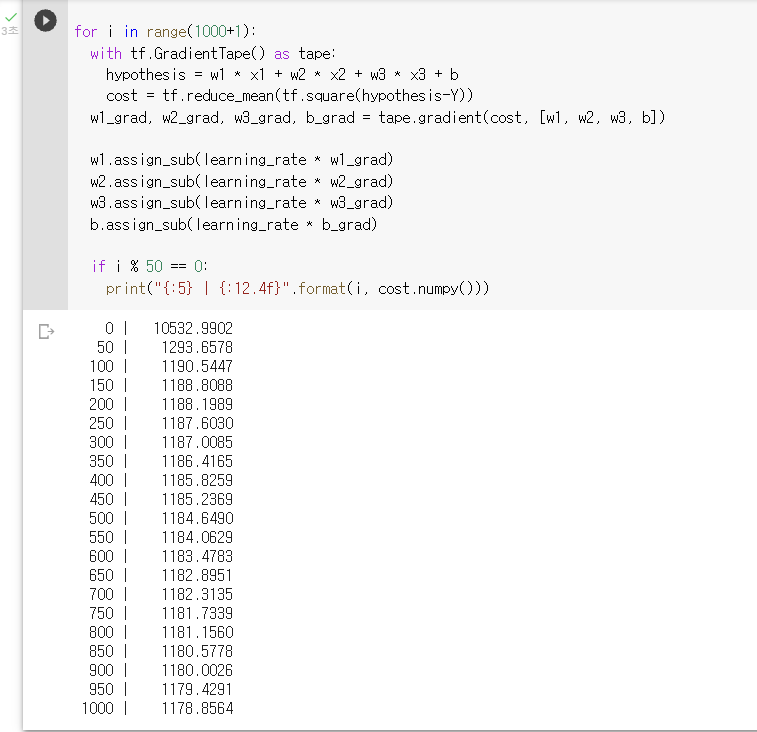Multi variable linear regression - Full Code
import tensorflow as tf
# data and label
x1 = [73., 93., 89., 96., 73.]
x2 = [80., 88., 91., 98., 66.]
x3 = [75., 93., 90., 100., 70.]
Y = [152., 185., 100., 196., 142.]
# random weights
w1 = tf.Variable(tf.random.normal([1]))
w2 = tf.Variable(tf.random.normal([1]))
w3 = tf.Variable(tf.random.normal([1]))
b = tf.Variable(tf.random.normal([1]))
learning_rate = 0.000001
for i in range(1000+1): #Gradient defent
#tf.GradientTape() to record the gradient of the cost function
with tf.GradientTape() as tape:
hypothesis = w1 * x1 + w2 * x2 + w3 * x3 + b
cost = tf.reduce_mean(tf.square(hypothesis-Y))
# calculates the gradients of the cost
w1_grad, w2_grad, w3_grad, b_grad = tape.gradient(cost, [w1, w2, w3, b])
#update w1, w2, w3 and b
w1.assign_sub(learning_rate * w1_grad)
w2.assign_sub(learning_rate * w2_grad)
w3.assign_sub(learning_rate * w3_grad)
b.assign_sub(learning_rate * b_grad)
if i % 50 == 0:
print("{:5} | {:12.4f}".format(i, cost.numpy()))
> 실행 결과

Matrix - Full Code
import tensorflow as tf
import numpy as np
data = np.array([
# x1, x2, x3, y
[73., 80., 75., 152. ],
[93., 88., 93., 185. ],
[89., 91., 90., 100., ],
[96., 98., 100., 196. ],
[73., 66., 70., 142. ]
], dtype=np.float32)
# slice data
X = data[:, :-1]
Y = data[:,[-1]]
W = tf.Variable(tf.random.normal([3,1]))
b = tf.Variable(tf.random.normal([1]))
learning_rate = 0.000001
# hypothesis, prediction function
def predict(x):
return tf.matmul(X, W) + b
n_epochs = 2000
for i in range(n_epochs+1):
# record the gradient of the cost function
with tf.GradientTape() as tape:
cost = tf.reduce_mean((tf.square(predict(X) - Y)))
# calculates the gradients of the Loss
W_grad, b_grad = tape.gradient(cost, [W, b])
#updates parameters (W and b)
W.assign_sub(learning_rate * W_grad)
W.assign_sub(learning_rate * b_grad)
if i % 100 == 0:
print("{:5} | {:10.4f}".format(i, cost.numpy()))
- slice data
x = data[:, :-1]
y = data[:,[-1]]
: 콤마를 기준으로 앞부분은 행 뒷부분은 열
: 콜론을 기준으로 앞뒤에 아무것도 안쓰여져 있기 때문에 처음부터 끝까지 즉, 모든 데이터를 뜻한다.
